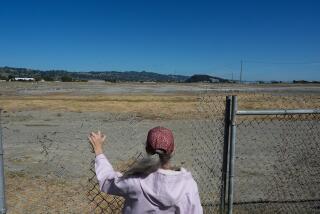Residents Ask EPA to Restore Golf Course : Environment: Those living near McColl dump site want guarantee the facility will be returned to its original state. Federal officials assure them it will.
FULLERTON — About 60 residents living near the McColl dump site told representatives of the Environmental Protection Agency Thursday night that they want a written guarantee that a golf course on the site will be fully restored when the hazardous waste is cleaned up.
“We’re tied of living with that,” said resident Mark S. Howells. “We want a golf course. The community is on the edge here.”
EPA representatives agreed to draft a statement affirming that the golf course could be restored.
Thursday’s meeting was the first large public gathering held by the EPA to discuss the McColl cleanup in about a year.
Originally a pig farm, the 22-acre site was used as a dumping ground for petroleum waste products produced by oil companies making aviation fuel during World War II. All told, officials believe, the oil companies--later determined to be Shell, Atlantic-Richfield, Texaco, Union and Phillips Petroleum--buried about 12,000 cubic yards of the waste in 12 sumps at the site.
A golf course was built there in 1960, followed by several hundred homes in the immediate vicinity in 1976. Two years later, the hazardous waste was rediscovered after lying dormant for several years, and disturbed residents and various concerned agencies began a tidal wave of lawsuits that have since kept the site tied up in litigation.
In 1982 the federal government declared the McColl dump area a Superfund site eligible for a massive cleanup that the EPA estimates could cost as much as $120 million. The oil companies--now united under the name of the McColl Site Group--are under court order to pay for most of the cleanup, an order they are in the process of appealing.
In the meantime, they are engaged in an ongoing disagreement with the EPA over which method of cleanup would be the most effective and financially viable.
The argument is expected to be settled after a three-month demonstration project scheduled to begin in January, during which the oil companies will use at least two methods to cover the petroleum waste in three of the site’s sumps. While some of the sumps will be filled with solid material, others simply will be capped.
EPA officials say they will decide which method to use based on the results of the three-month test. Once the appropriate method is determined, they say, the project can begin in late 1995. The complete cleanup, according to EPA officials, could take up to six years.
More to Read
Sign up for Essential California
The most important California stories and recommendations in your inbox every morning.
You may occasionally receive promotional content from the Los Angeles Times.










